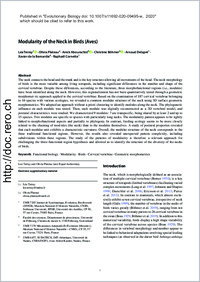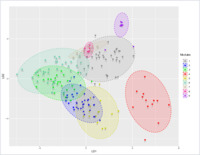Modularity of the neck in birds (Aves)
- Terray, Léa UMR 7205 Institut de Systématique, Evolution, Biodiversité (ISYEB), Muséum National D’Histoire Naturelle, CNRS, Sorbonne Université, EPHE, Université des Antilles, CP 50, 57 rue Cuvier, 75005 Paris, France
- Plateau, Olivia Faculté des sciences, Département de géosciences, Université de Fribourg, Chemin du musée 6, 1700 Fribourg, Switzerland
- Abourachid, Anick UMR 7179 Mécanismes Adaptatifs Et Evolution (Mecadev), Muséum National d’Histoire Naturelle – CNRS., CP 55, 57 rue Cuvier, 75231 Paris, France
- Böhmer, Christine UMR 7179 Mécanismes Adaptatifs Et Evolution (Mecadev), Muséum National d’Histoire Naturelle – CNRS., CP 55, 57 rue Cuvier, 75231 Paris, France
- Delapré, Arnaud UMR 7205 Institut de Systématique, Evolution, Biodiversité (ISYEB), Muséum National D’Histoire Naturelle, CNRS, Sorbonne Université, EPHE, Université des Antilles, CP 50, 57 rue Cuvier, 75005 Paris, France
- la Bernardie, Xavier de UMR 6457, SUBATECH, IMT-Atlantique, Université de Nantes, CNRS/IN2P3, 4 rue Alfred Kastler, Nantes, France
- Cornette, Raphaël UMR 7205 Institut de Systématique, Evolution, Biodiversité (ISYEB), Muséum National D’Histoire Naturelle, CNRS, Sorbonne Université, EPHE, Université des Antilles, CP 50, 57 rue Cuvier, 75005 Paris, France
-
18.03.2020
Published in:
- Evolutionary Biology. - 2020, vol. 47, no. 2, p. 97-110
English
The neck connects the head and the trunk and is the key structure allowing all movements of the head. The neck morphology of birds is the most variable among living tetrapods, including significant differences in the number and shape of the cervical vertebrae. Despite these differences, according to the literature, three morphofunctional regions (i.e., modules) have been identified along the neck. However, this regionalization has not been quantitatively tested through a geometric morphometric approach applied to the cervical vertebrae. Based on the examination of 187 cervical vertebrae belonging to 16 species with various ecologies, we revealed a common modular structure of the neck using 3D surface geometric morphometrics. We adopted an approach without a priori clustering to identify modules along the neck. The phylogenetic influence on each module was tested. Then, each module was digitally reconstructed as a 3D vertebral model, and postural characteristics were studied. We characterized 9 modules: 7 are transpecific, being shared by at least 2 and up to 15 species. Two modules are specific to species with particularly long necks. The modularity pattern appears to be tightly linked to morphofunctional aspects and partially to phylogeny. In contrast, feeding ecology seems to be more closely related to the chaining of modules (the neck) than to the modules themselves. A study of postural properties revealed that each modular unit exhibits a characteristic curvature. Overall, the modular structure of the neck corresponds to the three traditional functional regions. However, the results also revealed unexpected pattern complexity, including subdivisions within these regions. The study of the patterns of modularity is therefore a relevant approach for challenging the three-functional-region hypothesis and allowed us to identify the structure of the diversity of the necks of birds.
- Faculty
- Faculté des sciences et de médecine
- Department
- Département de Géosciences
- Language
-
- English
- Classification
- Biological sciences
- License
- License undefined
- Identifiers
-
- RERO DOC 328403
- DOI 10.1007/s11692-020-09495-w
- Persistent URL
- https://folia.unifr.ch/unifr/documents/308375
Other files
Statistics
Document views: 93
File downloads:
- pla_mnb.pdf: 433
- pla_mnb_sm.pdf: 137

